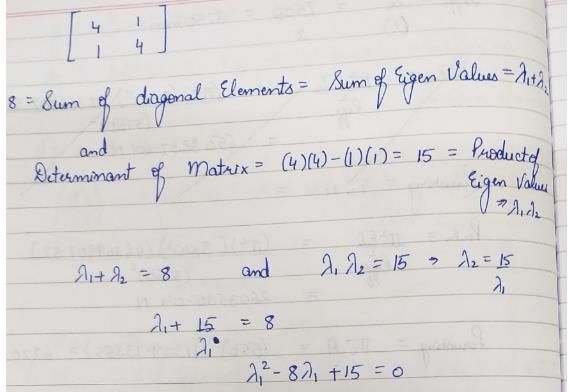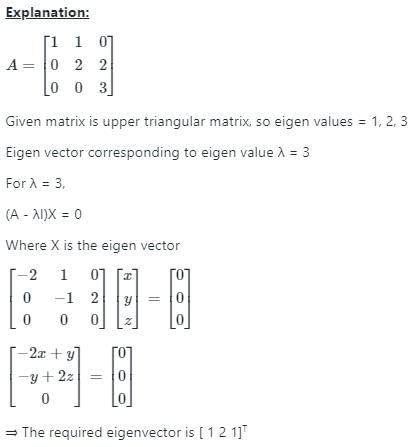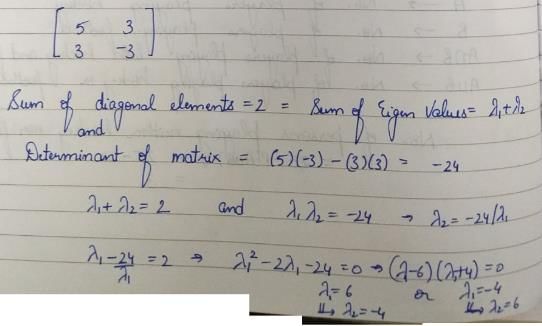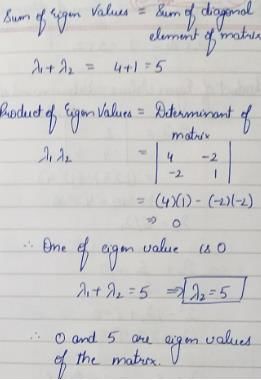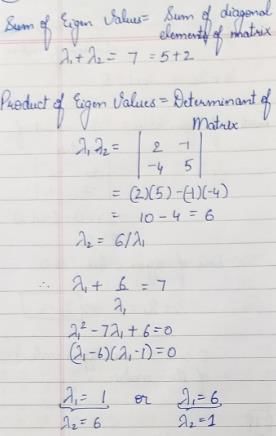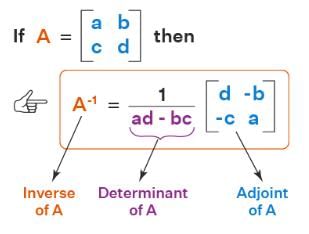All Exams >
Mechanical Engineering >
Engineering Mathematics for Mechanical Engineering >
All Questions
All questions of Linear Algebra for Mechanical Engineering Exam
If A is a non–singular matrix and the eigen values of A are 2 , 3 , -3 then the eigen values of A-1 are- a)2 , 3 , - 3
- b)1/2, 1/3, -1/3
- c)2|A|, 3|A|, -3|A|
- d)None of these
Correct answer is option 'B'. Can you explain this answer?
If A is a non–singular matrix and the eigen values of A are 2 , 3 , -3 then the eigen values of A-1 are
a)
2 , 3 , - 3
b)
1/2, 1/3, -1/3
c)
2|A|, 3|A|, -3|A|
d)
None of these
|
|
Tanishq Chavan answered |
If λ1 ,λ2 ,λ3 ....λn are the eigen values of a non–singular matrix A, then A-1 has the eigen values 1/λ1 ,1/λ2 ,1/λ3 ....1/λn Thus eigen values of A-1are 1/2, 1/3, -1/3
Given the matrix  the eigenvector is
the eigenvector is- a)

- b)

- c)

- d)

Correct answer is 'C'. Can you explain this answer?
Given the matrix  the eigenvector is
the eigenvector is
a)
b)
c)
d)
|
|
Ritika Bose answered |
Characteristic equation
The number of linearly independent eigenvectors of 
- a)0
- b)1
- c)2
- d)Infinit e
Correct answer is 'B'. Can you explain this answer?
The number of linearly independent eigenvectors of 
a)
0
b)
1
c)
2
d)
Infinit e
|
|
Pranjal Sen answered |
Number of linear independent vectors is equal to the sum of Geometric Multiplicity of eigen values. Here only eigen value is 2. To find Geometric multiplicity find n-r of (matrix-2I), where n is order and r is rank. Rank of obtained matrix is 1 and n=2 so n-r=1. Therefore the no of linearly independent eigen vectors is 1
For a skew symmetric even ordered matrix A of integers, which of the following will not hold true:- a)det(A) = 7
- b)det(A) = 81
- c)det(A) = 9
- d)det(A) = 4
Correct answer is option 'A'. Can you explain this answer?
For a skew symmetric even ordered matrix A of integers, which of the following will not hold true:
a)
det(A) = 7
b)
det(A) = 81
c)
det(A) = 9
d)
det(A) = 4

|
Mrinalini Chavan answered |
A skew symmetric matrix Anxn is a matrix with AT = -A. The matrix of (A) satisfy this condition.
The eigenvalues of

- a)-19,5,37
- b)19,-5,-37
- c)2,-3,7
- d)3,-5,37
Correct answer is option 'A'. Can you explain this answer?
The eigenvalues of


a)
-19,5,37
b)
19,-5,-37
c)
2,-3,7
d)
3,-5,37
|
|
Avinash Sharma answered |
The eigenvalues of an upper triangular matrix are simply the diagonal entries of the matrix.
Hence 5, -19, and 37 are the eigenvalues of the matrix. Alternately, look atd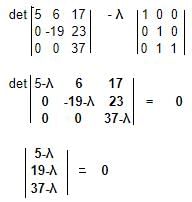

λ = 5, -19, 37
If -1 , 2 , 3 are the eigen values of a square matrix A then the eigen values of A2 are- a)-1 , 2 , 3
- b)1, 4, 9
- c)1, 2, 3
- d)None of these
Correct answer is option 'B'. Can you explain this answer?
If -1 , 2 , 3 are the eigen values of a square matrix A then the eigen values of A2 are
a)
-1 , 2 , 3
b)
1, 4, 9
c)
1, 2, 3
d)
None of these

|
Aditya Patel answered |
If λ1 ,λ2 ,λ3 ....λn are the eigen values of a matrix A, then A2 has the eigen values λ12 ,λ22 ,λ32 ....λn2 So, eigen values of A2 are 1, 4, 9.
If 1 and 3 are the eigenvalues of a square matrix A then A3 is equal to- a)13 (A - I2 )
- b)13A - 12 I2
- c)12 (A - I2)
- d)None of these
Correct answer is option 'B'. Can you explain this answer?
If 1 and 3 are the eigenvalues of a square matrix A then A3 is equal to
a)
13 (A - I2 )
b)
13A - 12 I2
c)
12 (A - I2)
d)
None of these

|
Pankaj Rane answered |
Since 1 and 3 are the eigenvalues of A so the characteristic equation of A is
Also, by Cayley–Hamilton theorem, every square matrix satisfies its own characteristic equation so
The three characteristic roots of the following matrix A 
- a)2,3
- b)1,2,2
- c)1,0,0
- d)0,2,3
Correct answer is option 'B'. Can you explain this answer?
The three characteristic roots of the following matrix A
a)
2,3
b)
1,2,2
c)
1,0,0
d)
0,2,3
|
|
Kabir Verma answered |
A is lower triangular matrix. So eigen values are only the diagonal elements.
If 2 and 4 are the eigen values of A then the eigenvalues of AT are
- a)1/2, 1/4
- b)2, 4
- c)4, 16
- d)None of these
Correct answer is option 'B'. Can you explain this answer?
If 2 and 4 are the eigen values of A then the eigenvalues of AT are
a)
1/2, 1/4
b)
2, 4
c)
4, 16
d)
None of these
|
|
Sanvi Kapoor answered |
The eigenvalues of a matrix A are the roots of the characteristic equation of A, which are invariant under the transpose operation. This means that the matrix A and its transpose AT have the same eigenvalues.
Given that 2 and 4 are the eigenvalues of A, the eigenvalues of AT will also be 2 and 4.
Eigen values of a matrix  are 5 and 1. What are the eigen values of the matrix S2 = SS?
are 5 and 1. What are the eigen values of the matrix S2 = SS?- a)1 and 25
- b)6 and 4
- c)5 and 1
- d)2 and 10
Correct answer is option 'A'. Can you explain this answer?
Eigen values of a matrix  are 5 and 1. What are the eigen values of the matrix S2 = SS?
are 5 and 1. What are the eigen values of the matrix S2 = SS?
a)
1 and 25
b)
6 and 4
c)
5 and 1
d)
2 and 10

|
EduRev GATE answered |
We know If λ be the eigen value of A ⇒λ2 is an eigen value of A2 .
For S matrix, if eigen values are λ1, λ2, λ3,... then for S² matrix, the eigen values will be λ²1 λ²2 λ²3......
For S matrix, if eigen values are 1 and 5 then for S² matrix, the eigen values are 1 and 25
For S matrix, if eigen values are 1 and 5 then for S² matrix, the eigen values are 1 and 25
In an M × N matrix such that all non-zero entries are covered in a rows and b column. Then the maximum number of non-zero entries, such that no two are on the same row or column, is - a)≤ a + b
- b)≤ max (a, b)
- c)≤ min[ M –a, N–b]
- d)≤ min {a, b}
Correct answer is option 'D'. Can you explain this answer?
In an M × N matrix such that all non-zero entries are covered in a rows and b column. Then the maximum number of non-zero entries, such that no two are on the same row or column, is
a)
≤ a + b
b)
≤ max (a, b)
c)
≤ min[ M –a, N–b]
d)
≤ min {a, b}

|
Naroj Boda answered |
Suppose a < b, for example let a = 3, b= 5, then we can put non-zero entries only in 3 rows and 5 columns. So suppose we put non-zero entries in any 3 rows in 3 different columns. Now we can’t put any other non-zero entry anywhere in matrix, because if we put it in some other row, then we will have 4 rows containing non-zeros, if we put it in one of those 3 rows, then we will have more than one non-zero entry in one row, which is not allowed.
So we can fill only “a” non-zero entries if a < b, similarly if b < a, we can put only “b” non-zero entries. So answer is ≤min(a,b), because whatever is less between a and b, we can put atmost that many non-zero entries.
If the rank of a (5×6) matrix Q is 4, then which one of the following statements is correct? - a)Q will have four linearly independent rows and four linearly independent columns
- b)Q will have four lineally independent rows and five lineally independent columns
- c)QQT will be invertible
- d)QTQ will be invertible
Correct answer is option 'A'. Can you explain this answer?
If the rank of a (5×6) matrix Q is 4, then which one of the following statements is correct?
a)
Q will have four linearly independent rows and four linearly independent columns
b)
Q will have four lineally independent rows and five lineally independent columns
c)
QQT will be invertible
d)
QTQ will be invertible

|
Kaavya Sengupta answered |
Given that rank Q is 4, so it will have 4 linearly independent columns as well as 4 linearly independent rows (∵ row rank of a matrix = column rank of a matrix)
So, A is correct and accordingly B is false.
C is false as order of QQ^T will be 5 x 5 and given that rank of Q is 4 i.e. < 5. So the matrix is QQ^T will be singular and hence not invertible.
Similarly D is false as order of Q^T Q will be 6 x 6 and the matrix is Q^T Q will be singular and hence not invertible.
For which value of x will the matrix given below become singular? 
- a)4
- b)6
- c)8
- d)12
Correct answer is option 'A'. Can you explain this answer?
For which value of x will the matrix given below become singular?
a)
4
b)
6
c)
8
d)
12

|
Gate Funda answered |
Let the given matrix be A. A is singular.
Cayley - Hamiltion Theorem states that square matrix satisfies its own characteristic equation, Consider a matrix
 A satisfies the relation
A satisfies the relation
- a)A +3I + 2A -2 =0
- b)A2+2A +2I=0
- c)(A+1I)( A+2I)=0
- d)exp(A) =0
Correct answer is option 'C'. Can you explain this answer?
Cayley - Hamiltion Theorem states that square matrix satisfies its own characteristic equation, Consider a matrix
A satisfies the relation
a)
A +3I + 2A -2 =0
b)
A2+2A +2I=0
c)
(A+1I)( A+2I)=0
d)
exp(A) =0

|
Telecom Tuners answered |
Characteristic equation of A is
The state variable description of a linear autonomous system is, X= AX, Where X is the two dimensional state vector and A is the system matrix given by  The roots of the characteristic equation are
The roots of the characteristic equation are - a)-2 and +2
- b)-j2 and +j2
- c)-2 and -2
- d)+2 and +2
Correct answer is option 'A'. Can you explain this answer?
The state variable description of a linear autonomous system is, X= AX,
Where X is the two dimensional state vector and A is the system matrix given by 
The roots of the characteristic equation are
a)
-2 and +2
b)
-j2 and +j2
c)
-2 and -2
d)
+2 and +2
|
|
Janhavi Sarkar answered |
Characteristic equation will be :λ2 -4 =0 thus root of characteristic equation will be +2 and - 2.
The eigen values of the following matrix are 
- a)3, 3 + 5j, –6 – j
- b)–6 + 5j, 3 + j, 3 – j
- c)3+ j, 3 – j, 5 + j
- d)3, –1 + 3j, –1 – 3j
Correct answer is option 'D'. Can you explain this answer?
The eigen values of the following matrix are
a)
3, 3 + 5j, –6 – j
b)
–6 + 5j, 3 + j, 3 – j
c)
3+ j, 3 – j, 5 + j
d)
3, –1 + 3j, –1 – 3j
|
|
Janhavi Singh answered |
Let the matrix be A. We know, Trace (A)=sum of eigen values.
Select a suitable figure from the four alternatives that would complete the figure matrix.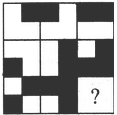

- a) 1
- b) 2
- c) 3
- d)4
Correct answer is option 'D'. Can you explain this answer?
Select a suitable figure from the four alternatives that would complete the figure matrix.
a)
1
b)
2
c)
3
d)
4
|
|
Kiran Datta answered |
In each row (as well as each column), the third figure is a combination of all the, elements of the first and the second figures
The following system of equations  has a unique solution. The only possible value(s) for a is/are
has a unique solution. The only possible value(s) for a is/are - a)0
- b)either 0 or 1
- c)one of 0, 1 or –1
- d)any real number other than 5
Correct answer is option 'D'. Can you explain this answer?
The following system of equations
has a unique solution. The only possible value(s) for a is/are
a)
0
b)
either 0 or 1
c)
one of 0, 1 or –1
d)
any real number other than 5

|
Gate Funda answered |
System has unique Soln if rank (A) = rank ( A ) = 3 . It is possible if a ≠ 5.
The eigen values of a skew-symmetric matrix are- a)Always zero
- b)always pure imaginary
- c)Either zero or pure imaginary
- d)always real
Correct answer is option 'C'. Can you explain this answer?
The eigen values of a skew-symmetric matrix are
a)
Always zero
b)
always pure imaginary
c)
Either zero or pure imaginary
d)
always real

|
Byomkesh Kamila answered |
Here,(a_ij)=-(a_ji)#for all diagonal elements,a_ij=a_ii =a_jj.
a_ii=-a_ii#2a_ii=0#a_ii=0/2=0 for all values of i≤n.
a_ii=-a_ii#2a_ii=0#a_ii=0/2=0 for all values of i≤n.
For the following set of simultaneous equations:
1.5x – 0.5y = 2
4x + 2y + 3z = 9
7x + y + 5z = 10 - a)The solution is unique
- b)Infinitely many solutions exist
- c)The equations are incompatible
- d)Finite number of multiple solutions exist
Correct answer is option 'A'. Can you explain this answer?
For the following set of simultaneous equations:
1.5x – 0.5y = 2
4x + 2y + 3z = 9
7x + y + 5z = 10
1.5x – 0.5y = 2
4x + 2y + 3z = 9
7x + y + 5z = 10
a)
The solution is unique
b)
Infinitely many solutions exist
c)
The equations are incompatible
d)
Finite number of multiple solutions exist

|
Dipika Nambiar answered |
(a)
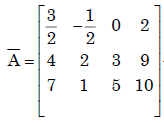
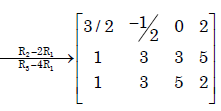
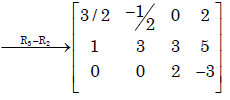
∴ rank of( ) = rank of(A) = 3
) = rank of(A) = 3
∴ The system has unique solution.
The system of linear equations
4x + 2y = 7
2x + y = 6 has
- a)A unique solution
- b)no solution
- c)An infinite number of solutions
- d)exactly two distinct solutions
Correct answer is option 'B'. Can you explain this answer?
The system of linear equations
4x + 2y = 7
2x + y = 6 has
4x + 2y = 7
2x + y = 6 has
a)
A unique solution
b)
no solution
c)
An infinite number of solutions
d)
exactly two distinct solutions
|
|
Rhea Reddy answered |
(b) This can be written as AX = B Where A
Angemented matrix


rank(A) ≠ rank( ). The system is inconsistant .So system has no solution.
). The system is inconsistant .So system has no solution.
The eigen values and the corresponding eigen vectors of a 2 × 2 matrix are given by
- a)

- b)

- c)

- d)

Correct answer is option 'A'. Can you explain this answer?
The eigen values and the corresponding eigen vectors of a 2 × 2 matrix are given by
a)
b)
c)
d)

|
Subodh Sharma answered |
Trace = sum of diagonal elements = sum of eigen value = 12
Only option (a) is satisfied.
Only option (a) is satisfied.
The sum of the eigenvalues of  is equal to
is equal to - a)18
- b)15
- c)10
- d)none of these
Correct answer is option 'A'. Can you explain this answer?
The sum of the eigenvalues of  is equal to
is equal to
a)
18
b)
15
c)
10
d)
none of these
|
|
Zoya Sharma answered |
- Since the sum of the eigenvalues of an n–square matrix is equal to the trace of the matrix (i.e. sum of the diagonal elements)
- So, required sum = 8 + 5 + 5 = 18
Solution for the system defined by the set of equations
4y + 3z = 8;
2x – z = 2
and 3x + 2y =5 is - a)x = 0; y = 1; z = 4/3
- b)x = 0; y = 1/2 ; z = 2
- c)x = 1; y = 1/2 ; z = 2
- d)non-existent
Correct answer is option 'D'. Can you explain this answer?
Solution for the system defined by the set of equations
4y + 3z = 8;
2x – z = 2
and 3x + 2y =5 is
4y + 3z = 8;
2x – z = 2
and 3x + 2y =5 is
a)
x = 0; y = 1; z = 4/3
b)
x = 0; y = 1/2 ; z = 2
c)
x = 1; y = 1/2 ; z = 2
d)
non-existent
|
|
Dishani Desai answered |
Ans.(d)
Consider the matrix A = ,Now det (A) = 0
,Now det (A) = 0
So byCramer's Rule the system has no solution
Consider the matrix A =
So byCramer's Rule the system has no solution
Find the Eigenvalues of matrix

- a)8, 2
- b)3, -3
- c)-3, -5
- d)5, 0
Correct answer is option 'A'. Can you explain this answer?
Find the Eigenvalues of matrix
a)
8, 2
b)
3, -3
c)
-3, -5
d)
5, 0
|
|
Sanya Agarwal answered |
A - λI = 0

Now, After taking the determinant:

(4 - λ)2 - 1 = 0
16 + λ2 - 8λ - 1 = 0
λ2 - 8λ + 15 = 0
(λ
- 3) (
λ - 5) = 0
λ
= 3, 5
For what value of a, if any, will the following system of equations in x, y and z have a solution?
2x + 3y = 4
x+y+z = 4
x + 2y - z = a- a)Any real number
- b)0
- c)1
- d)There is no such value
Correct answer is option 'B'. Can you explain this answer?
For what value of a, if any, will the following system of equations in x, y and z have a solution?
2x + 3y = 4
x+y+z = 4
x + 2y - z = a
2x + 3y = 4
x+y+z = 4
x + 2y - z = a
a)
Any real number
b)
0
c)
1
d)
There is no such value
|
|
Aditya Deshmukh answered |
The correct answer is d.
2x + 3y = 4 ....(1)
x + y + z = 4 ....(2)
x + 2y – z = a ....(3)
add (2) and (3),
x + y + z + x + 2y – z = 4 + a
2x + 3y = 4 + a ....(4)
from (1) and (4),
value of a must be 0 otherwise no solution
Consider the system of equations given below:
x + y = 2
2x + 2y = 5
This system has- a)One solution
- b)No solution
- c)Infinite solution
- d)Four solution
Correct answer is option 'B'. Can you explain this answer?
Consider the system of equations given below:
x + y = 2
2x + 2y = 5
This system has
x + y = 2
2x + 2y = 5
This system has
a)
One solution
b)
No solution
c)
Infinite solution
d)
Four solution

|
Bijoy Mehra answered |
(b) This can be written as AX = B Where A
Angemented matrix


rank(A) ≠ rank( ). The system is inconsistant .So system has no solution.
). The system is inconsistant .So system has no solution.
The lower triangular matrix [L] in the [L][U] decomposition of the matrix given below
 is
is- a)

- b)

- c)

- d)

Correct answer is option 'A'. Can you explain this answer?
The lower triangular matrix [L] in the [L][U] decomposition of the matrix given below


is
a)

b)

c)

d)

|
|
Sanya Agarwal answered |
We must first complete the first step of forward elimination

First step: Multiply Row 1 by 10/25 = 0.4 and subtract the results from Row 2

Multiply Row 1 by 8/25 = 0.32, and subtract the results from Row 3


First step: Multiply Row 1 by 10/25 = 0.4 and subtract the results from Row 2

Multiply Row 1 by 8/25 = 0.32, and subtract the results from Row 3

To find ℓ21 and ℓ31 , what multiplier was used to make the a21 and a31 elements zero in the first step of forward elimination using the Naïve Gauss elimination method? They are
ℓ21 = 0.4
ℓ31 = 0.32
To find ℓ32, what multiplier would be used to make the a32 element zero? Remember the a32 element is made zero in the second step of forward elimination.
So

Hence

ℓ21 = 0.4
ℓ31 = 0.32
To find ℓ32, what multiplier would be used to make the a32 element zero? Remember the a32 element is made zero in the second step of forward elimination.
So

Hence

Let A be an n x n complex matrix. Assume that A is self-adjoint and let B denotes the inverse of (A + iIn). Then all eigenvalues of (A - iIn)B are - a)purely imaginary
- b)of modulus one
- c)real
- d)of modulus less than one
Correct answer is option 'B'. Can you explain this answer?
Let A be an n x n complex matrix. Assume that A is self-adjoint and let B denotes the inverse of (A + iIn). Then all eigenvalues of (A - iIn)B are
a)
purely imaginary
b)
of modulus one
c)
real
d)
of modulus less than one

|
Meghana Kaur answered |
- Self-adjoint Matrix: A self-adjoint (Hermitian) matrix A has real eigenvalues.
- Matrix B: B is the inverse of (A - iIn).
- Eigenvalues of (A - iIn)B:
- (A - iIn)B is the identity matrix, as B is the inverse of (A - iIn).
- The eigenvalues of the identity matrix are 1.
- Conclusion: All eigenvalues of (A - iIn)B have modulus one, making option B correct.
Chapter doubts & questions for Linear Algebra - Engineering Mathematics for Mechanical Engineering 2025 is part of Mechanical Engineering exam preparation. The chapters have been prepared according to the Mechanical Engineering exam syllabus. The Chapter doubts & questions, notes, tests & MCQs are made for Mechanical Engineering 2025 Exam. Find important definitions, questions, notes, meanings, examples, exercises, MCQs and online tests here.
Chapter doubts & questions of Linear Algebra - Engineering Mathematics for Mechanical Engineering in English & Hindi are available as part of Mechanical Engineering exam.
Download more important topics, notes, lectures and mock test series for Mechanical Engineering Exam by signing up for free.
Engineering Mathematics for Mechanical Engineering
53 videos|124 docs|63 tests
|

Contact Support
Our team is online on weekdays between 10 AM - 7 PM
Typical reply within 3 hours
|
Free Exam Preparation
at your Fingertips!
Access Free Study Material - Test Series, Structured Courses, Free Videos & Study Notes and Prepare for Your Exam With Ease

 Join the 10M+ students on EduRev
Join the 10M+ students on EduRev
|

|
Create your account for free
OR
Forgot Password
OR
Signup to see your scores
go up within 7 days!
Access 1000+ FREE Docs, Videos and Tests
Takes less than 10 seconds to signup


